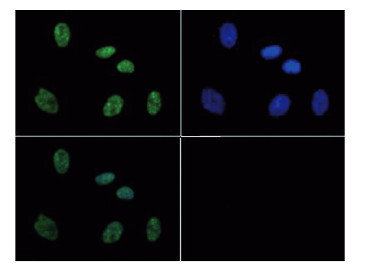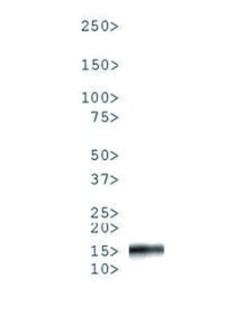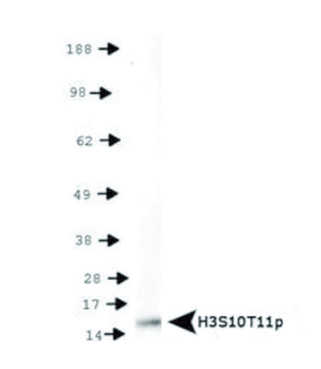1

Anti-H3S10pT11p | Histone H3 (p Ser10, p Thr11)
- Product Info
-
Immunogen: KLH-conjugated synthetic peptide Host: Rabbit Clonality: Polyclonal Purity: Immunogen affinity purified serum. Format: Liquid Quantity: 50 µg Storage: Store lyophilized/reconstituted at -20°C; once reconstituted make aliquots to avoid repeated freeze-thaw cycles. Please remember to spin the tubes briefly prior to opening them to avoid any losses that might occur from material adhering to the cap or sides of the tube. Tested applications: Chromatin immunoprecipitation (ChIP), Immunofluorescence (IF), Immunohistochemistry (IHC), Western blot (WB) Recommended dilution: 2-5 µg/million cells (ChIP), 1 : 200 (IF), 1 : 200 (IHC), 1 : 500 (WB) Expected | apparent MW: 15 kDa
- Reactivity
-
Confirmed reactivity: Caenorhabditis elegans, Human Predicted reactivity: Chicken, Drosophila melanogaster, Mouse, Plant, Rat, Xenopus sp. Not reactive in: No confirmed exceptions from predicted reactivity are currently known - Application Examples
-
application example 
Immunofluorescence using anti-H3S10pT11p antibodies. Tissue: HeLa cells. Fixation: 0.5% PFA. Primary antibody: H3S10pT11p antibody at a 1:200 dilution for 1 h at RT. Secondary antibody: FITC secondary antibody at 1:10 000 for 45 min at RT. Localization: H3S10pT11p is nuclear and chromosomal. Staining: H3S10pT11p is expressed in green, nuclei are counterstained with Dapi (blue).
Western Blot using anti-H3S10pT11p antibodies. 30 μg C. elegans embryo lysate. Primary antibody: H3S10pT11p at a 1:500 dilution overnight at 4°C. Secondary antibody: IRDye800™ rabbit secondary antibody at 1:10,000 for 45 min at RT.
Western Blot using anti-H3S10pT11p antibodies. 30 μg HeLa histone extracts. Primary antibody: H3S10pT11p at a 1:500 dilution overnight at 4°C. Secondary antibody: IRDye800™ rabbit secondary antibody at 1:10 000 for 45 min at RT. - Additional Information
-
Additional information: This antibody preparation is provided in 20 mM Potassium Phosphate pH 7,2, 150 mM NaCl, 0,01% sodium azide and 30% glycerol - Background
-
Background: When confronted with DNA damage or the lack of certain kinases like Chk1 and Aurora1, histone H3 is phosphorylated at T11, causing a reduction in acetylation of the same histone at K9 and ultimately leading to a reduction of active transcription in affected cells. When the T11 phosphorylation is combined with a typical S10 phosphorylation that is critical in chromosome condensation in metaphase, the effect on transcriptional regulation is amplified further. Phosphorylation of H3S10 is decreased by T11 phosphorylation. Thus, detection of the combined modification is critical in determining transcriptional effects, especially when contrasted against single modifications of H3. - Reviews:
-
This product doesn't have any reviews.
Accessories



